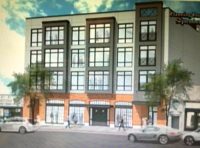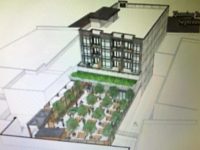First Parking-Space-Free Apt. Building Proposed in White Plains

At the Sept. 20 meeting of the White Plains Planning Board, the first multi-family housing development proposal that does not include plans for on-site parking gave rise to an engaged discussion about the driving habits of young residents being attracted to the city.

The development site, located at 199-201 E. Post Rd. is a little over a quarter acre with a 5,000 square-foot first floor space and 3,500 square foot basement. It is the site of the former Thirsty Turtle. The property, which is in disrepair on both the inside and outside of the existing building, went into foreclosure and has been vacant for several years.
The building was recently acquired and the new owner has hired White Plains architect John Sullivan to work up a new design that includes a newly renovated family-style restaurant and beer garden on the ground floor and an addition of three stories to include 18 one-bedroom apartments, six units on each level.
The White Plains Affordable Housing requirement is applicable to the project, however no specifics were given.
The CB-1 zoning in the area allows the building height. The applicant is seeking a site plan amendment and arrangements for payment in lieu of parking. The CB-1 zone requires one parking space per residential unit.
Sewage requirements for the residences and stormwater management based on the 50-year storm model were discussed.
The Building Permit for the restaurant renovation is already in place and work is underway. Structural modifications to accommodate additional floors will be added, but no upper level construction will begin until the site plan is approved.
Board chairman John Ioris noted that the developer in looking at the market had “obviously made a decision to build residences with no parking and that it was the developer’s risk. I have no problem with it,” Ioris said.
The fee in lieu of building parking spaces is $260,000.
Board member Lynn Oliva, concerned that residents and guests of the building would potentially park in the Car Hart neighborhood rather than pay for daytime garage parking, asked for information about the current usage of parking garages in the area.
“How many other lots along E. Post Road might be developed and ask for the same thing?” Olivia asked. “Because of the precedent, we have to ask. What are the vacancy rates in the city’s parking garages?”
Other Board members agreed, noting that during the evening hours parking is difficult to find in downtown White Plains.
Sullivan explained that there was no way to provide parking on the site and supported his client’s decision to build residences without provided parking.
According to Sullivan, the intended market would be people working in the restaurant on site as well as in establishments along Mamaroneck Avenue. In the new urban model, units are smaller and occupied by Millennials who do not have cars, Sullivan said. “They are big users of Uber and Zip Cars,” he added.
The expected rents are $1,700 to $1,900 per unit.
Sullivan further projected that within 10 years urban areas will have empty parking lots because people will not own cars.
Oliva countered that she had heard another developer contest the belief that Millennials were not buying cars.
A July 27, 2018 article in Forbes, “Millennials – Once Viewed as Auto Market’s Lost Generation – Now Are Its Biggest Growth Driver,” by Dale Buss, stated: “It turns out that Millennials were responsible for all new-vehicle sales growth in North America during the first quarter of 2018, according to data compiled by Experian, the credit-information company. More specifically, Millennial market share increased to 29.7 percent during the period from 27.9 percent in the first quarter of 2017, while market shares from other generations remained unchanged or fell in the same period, when overall U.S. car sales were leveling off after an eight-year boom.”
“The [Millennial] demographic is maturing and is now poised to be a driving force in automotive marketing,” said Marty Miller, senior product marketing manager for Experian Automotive, in a blog post. “In short, they are growing up.”
But then, the Millennial generation was born in the mid-1990s to early 2000s. They are getting older and settling down. The next group coming up is Generation Z and they may very well follow in their predecessors’ footsteps as the urban lifestyle continues to be attractive to young people.


